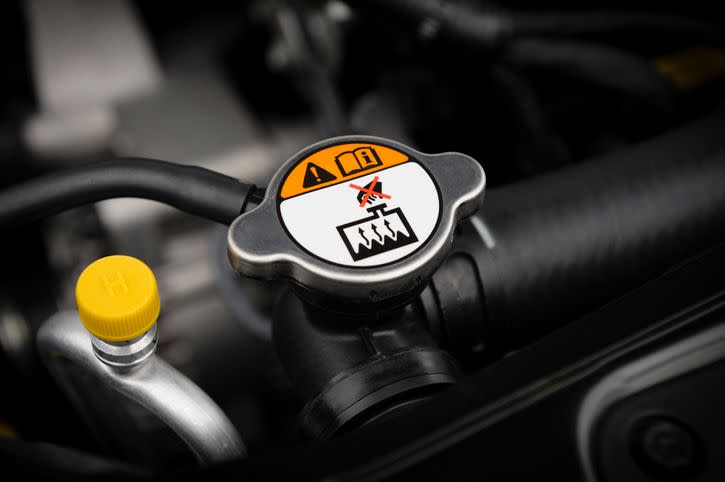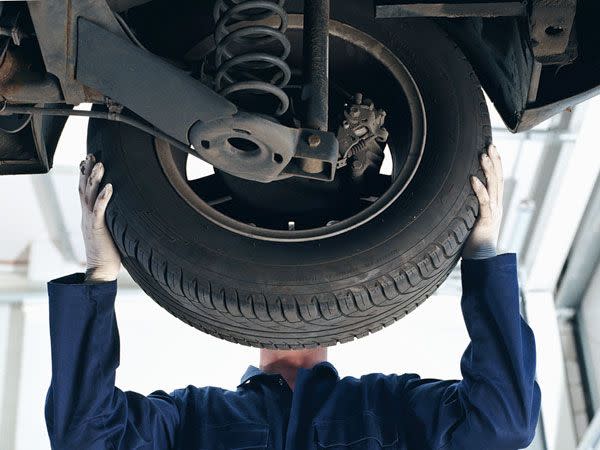How to Get Your Car Ready For Your Next Road Trip

You’ve been stuck in the same dull places for weeks, or maybe months. Your attention keeps drifting away to places you’d rather be, all of which are not here. Maybe the weather is too pleasant to ignore. Maybe you’d like to go somewhere snowy because it never snows at home. There are so many people to see, good roads to drive, places you love and even more places you haven’t explored. Either way, you need to load up your car and hit the highway.
It’s road trip time.
However, all of your best planning will be for naught if you can't depend on your car. A breakdown on your daily commute is one thing, but what if your car leaves you stranded miles outside the middle of nowhere? Car care is necessary year-round, but especially before a road trip, so complete these basic maintenance tasks before becoming a horror movie cliché.
Fluids

Fluids are the lifeblood of any car. Service intervals on your car's six essential fluids usually depend on mileage, so consider how far you've driven since your last service, and how far you plan to go on your trip in order to decide what needs attention. If you’re going to hit a service milestone mid-trip, you may want to take care of that job early.
Oil: You don't need to be a car expert to know that oil is critical for an engine. It lubricates moving components like the pistons, crankshaft and camshaft so they can move without too much friction. The recommended interval for oil changes used to be every 3,000 to 5,000 miles, but technology has improved since then—both in your oil and under your hood. Many automakers now recommend changing your oil every 7,500 to 10,000 miles according to Consumer Reports. Double-check your manual before setting a regular schedule for oil changes. If you've gotten an oil change within your recommended timeframe, use the dipstick to check the oil condition and fill level. If it's black, gritty or below the minimum fill line, get it checked out right away.
Radiator fluid: Engines produce a lot of heat and the radiator keeps it cool. Radiator fluid, which is also known as coolant or antifreeze, works to extract heat from the engine and dissipates it through the radiator. A low coolant level will likely result in overheating, so check your coolant and top it off if need be. Make sure to flush the system at least every 40,000 to 50,000 miles.
Brake fluid: When you push the brake pedal, fluid—yes, fluid—compresses inside the brake lines, forcing the brake pads to clamp on the rotors and slow down your car. If you ever notice that the pedal feels spongy or has extra travel, there may be air bubbles in the lines or the fluid may be contaminated. In the case of a spongy pedal, you’ll need to bleed those air bubbles out of the lines. Otherwise, be sure to top off the brake fluid if necessary, and flush the system with fresh fluid every 24,000 miles.
Power steering fluid: Modern cars use power steering to make turning the wheel easy at any speed, but this fluid can also become contaminated, making your steering less responsive. It’s a good idea to check the level and condition of your fluid every time you change your car’s oil. You should change your power steering fluid about every 50,000 miles regardless.
Transmission fluid: Few things ruin a drive like a jerky transmission. Transmission fluid helps gears mesh smoothly, and when it goes bad, uncomfortable shifts can be the result. Fortunately, transmission fluid lasts a long time, and some cars are even sold with so-called "lifetime" transmission fluid. Check your owner’s manual for the recommended service interval for your specific car as they can vary from 30,000 miles all the way up to over 100,000 miles, per Consumer Reports. Generally, though, it's a good idea to replace the fluid at 60,000 miles anyway, even if you have that “lifetime” fluid. You are more likely to run into problems with transmission fluid that’s older than 100,000 miles.
Windshield fluid: Long drives can make your car filthy and there's nothing on your car's exterior more important to keep clean than the windshield. After all, you have to be able to see where you're going. Adding windshield washer fluid is super basic:get a jug of fluid at any gas station, then use a funnel to fill up your reservoir if it gets low.
Tires

As you'd expect, tires are paramount to safety, comfort and fuel efficiency, so it's important to check their condition before you leave.
Air pressure – 1,000 miles: Every road tripper needs good gas mileage whenever there’s an ominous “Next Gas 130 Miles” sign appears, and underinflated tires are guaranteed to waste gas. Conversely, overinflated tires make ride quality worse because they're less compliant. The wrong air pressure also causes tires to wear unevenly, which shortens the tires’ lifespan. Most cars will tell you how much air you need in your tires in the owner’s manual or on a sticker inside the driver’s door. Check yourtire pressures before you leave, and then roughly every 1,000 miles as you travel. Be sure to check your tire pressure again if you encounter a significant change in temperature, as that affects the pressure within your tires as well.
Rotation – 5,000 to 8,000 miles: Even if your tire pressure is correct, variations in suspension calibration, weight balance, driving habits and road conditions make tires wear at different rates. Because of this, it's important to periodically rotate your tires between different locations on your car. Swapping tires from right to left or front to rear helps them last longer because each spot wears down a tire in different areas. Tire rotations should be completed every 5,000 to 8,000 miles, or as soon as you notice that one side of your tire tread has worn down significantly faster than the other side.
Replacement – 25,000 to 50,000 miles: If your tires are starting to look pretty bald the penny test is an easy way to check if it’s time for replacements. Stick a penny into the groove of your tire tread with Abraham Lincoln’s head facing into the groove. If you can see the top of Lincoln’s head, it’s time to replace your tires. If it’s close, you should replace your tires before you leave on a longer road trip While most tires last anywhere from 25,000 to 50,000 miles depending on their type and use, if damage like punctures, exposed cords or sidewall bulges occur, replace them immediately.
General Maintenance

Cars have numerous components that must be maintained to stay in good working order, so make sure to check these parts before you hit the road.
Brake pads: Brake pads provide the friction needed to slow and stop your car. They wear away with use, eventually becoming too thin to work effectively. Usually it's obvious when this happens due to the irritating screeching or squealing noise they make when there isn’t enough pad material left. Replacing the brake pads should fix the noise and more importantly, make your road trip safer. Depending on what your brake pads are made of and how they're used, they can last anywhere from 25,000 to 70,000 miles.
Air filters: The road is a dirty place. Cars use air filters to prevent dust, debris and bugs from entering the engine and interior. Eventually these air filters reach capacity and can become clogged, impacting engine performance, fuel economy and interior air quality. Your engine air filter should be replaced about once a year or roughly every 10,000 to 15,000 miles, and your cabin filter should last between 12,000 and 15,000 miles. Fortunately, these are usually inexpensive and easy to change.
Light bulbs: Having a burnt out headlight, taillight or blinker is an easy way to get pulled over on a drive. To make sure they’re all in working order, turn on your car, leave it in park, switch on the headlights, and walk around the car to see if any bulbs are burnt out. Repeat the process for the left and right turn signals. With the car still in park, hold the brake pedal down with a brick so you can check the condition of your brake lights.
Belts and hoses: Looking under the hood of your car can be intimidating, but there are a few obvious signs of trouble that anyone can spot. Press on the belts down to make sure they're tight.There should be very little slack, and if the belt has teeth, none of the teeth should come loose when you push on the belt. If the belt does skip any teeth, don’t try to drive it! While you’re in there, look for any visible cracking, fraying or missing teeth in the belts, which indicate that they need to be replaced. Check the hoses to see if there's any fluid leaks, especially towards the ends of each hose. Having a hose or a belt fail in the middle of a drive can spell disaster for an engine and leave you stranded—potentially without a fixable car.
Yep, it's not secret that car care can be a pain. But it's not nearly as bad as having an adventure ruined by a preventable problem. Your car works hard on a road trip, so give it what it need to keep running.
Tidy Up
If you’re going to be stuck in one vehicle for a long time, make sure it’s pleasant to be in there in the first place.
Clean Inside and Out: Nothing’s worse than taking a road trip in a grimy, smelly car, so cleaning the interior should be a priority before you set off. Pay close attention to anything you frequently come into contact with: seats, floor mats, storage areas and dashboard controls. The last thing you want to do is to dump a full Big Gulp in your lap because it stuck to the grime in the bottom of the cupholder. Make sure the trunk is clean so it won’t damage your luggage or any souvenirs you pick up along the way. Don’t forget to also give the exterior a good wash before you leave. Bugs and bird poop are notorious for eating paint, and you’ll be encountering a lot of those on the open road.
Organize: One of the most maddening feelings on a long trip is getting buried in a disorganized mess where you can’t find anything you need. Organize your car’s interior before you leave so this isn’t a problem. Make sure frequently used storage areas—especially your cupholders—are in working condition. Pack enough cords and power adapters to power all of the phones, navigation systems and other electronics you may want to bring, and figure out where those cords should be routed before you lose them all in the canyon between the front seats and the center console. Lastly, designate a specific bin or bag for trash. This helps keep your interior clean and your trip-mates calm.
It's no secret that car care can be a pain, but it's not nearly as bad as having an adventure ruined by a preventable problem. Your car works hard on a road trip, so give it what it needs to keep running.
You Might Also Like

